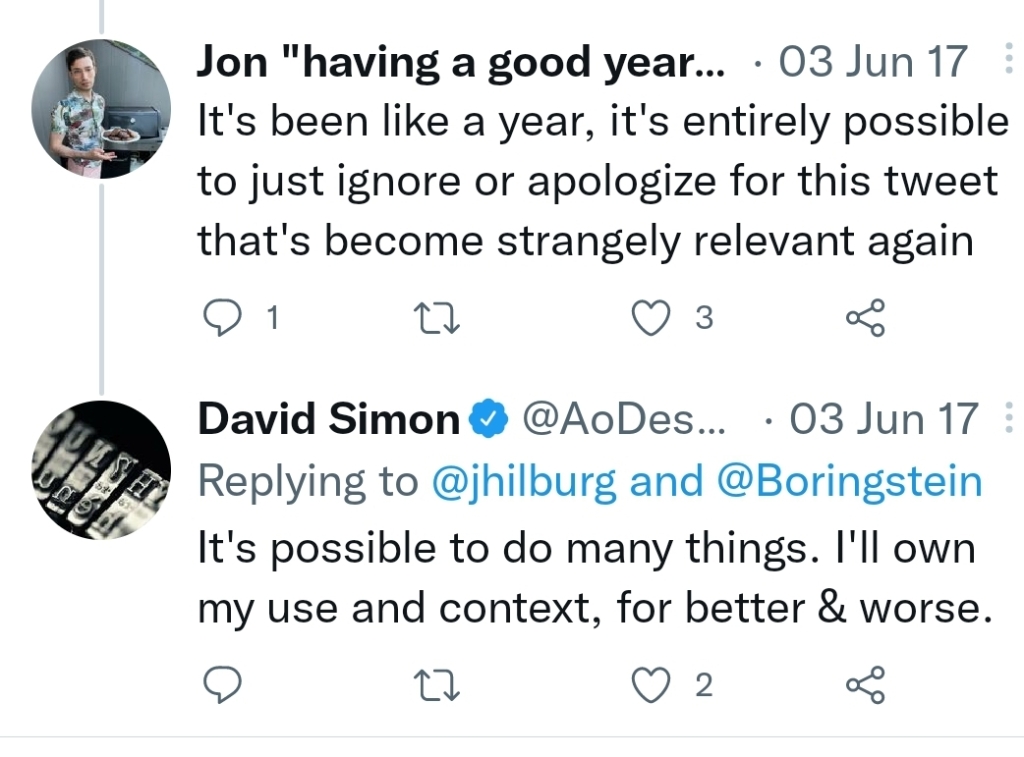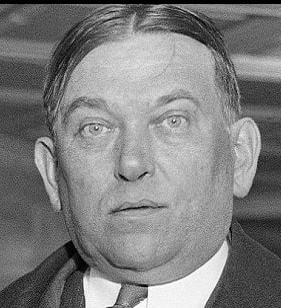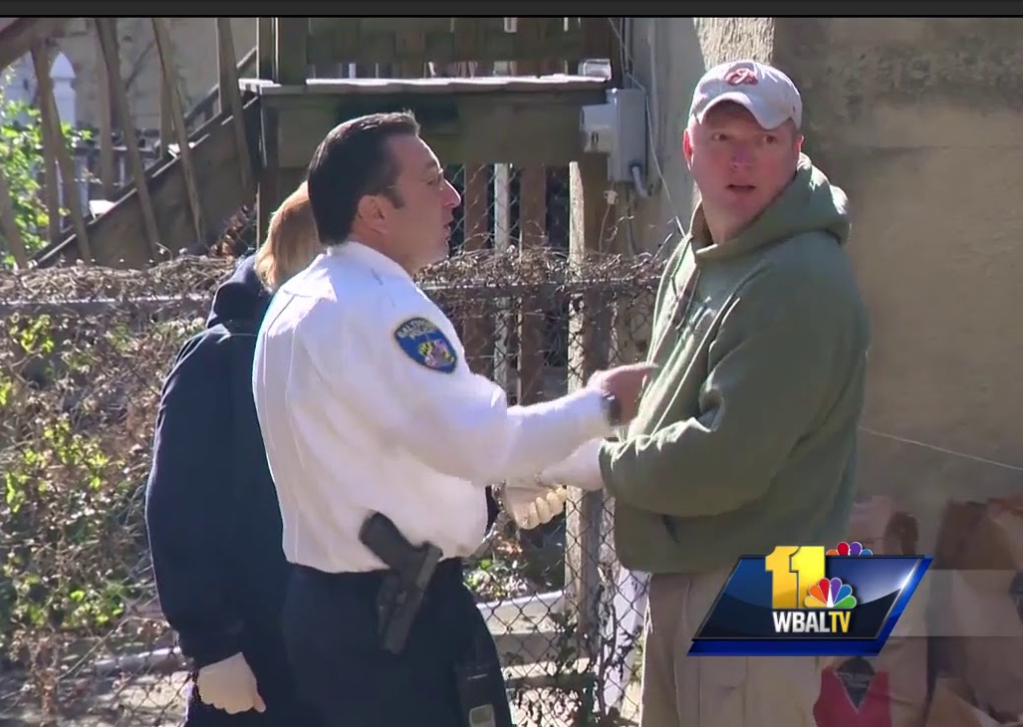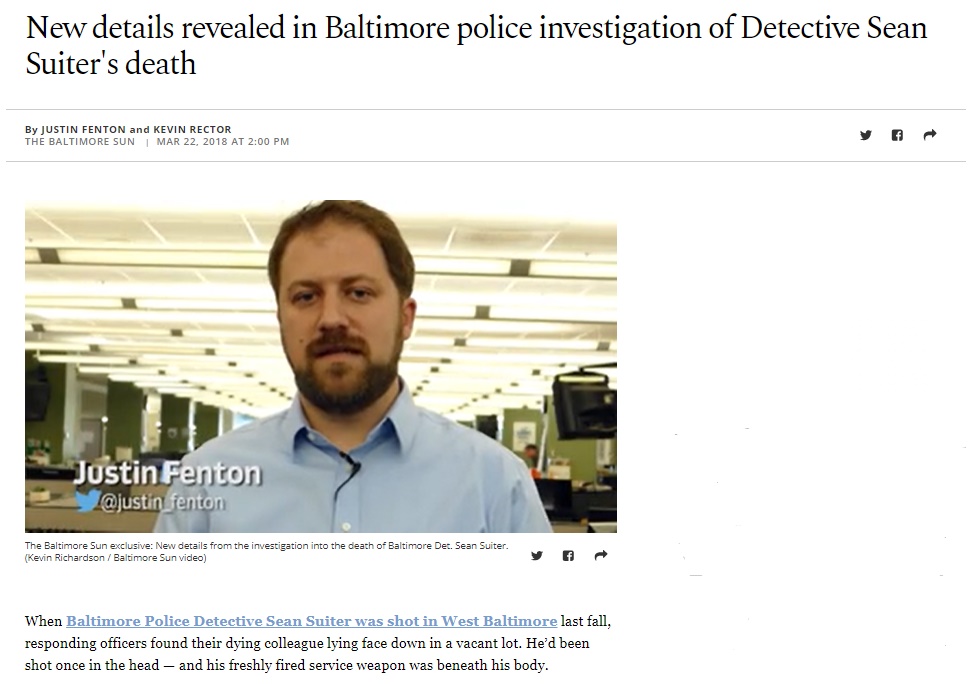In all the ways that count most to Black people David Simon unequivocally embodies the absolute worst of what is known as the “white moderate” male in the United States. Although his infractions are numerous, what draws the most ire is Simon’s casual and frequent use of “nigger” and “nigga”.
The most noteworthy incident in question occurred (not surprisingly) in the Trump era with Simon tweeting “Hannity my nigga!” on Monday 19 September 2016. It was a tongue-in-cheek greeting between two white men in response of then-presidential candidate Donald Trump’s announcement of a planned outreach effort to engage Black voters.
Although a firestorm ensued, it was not the first time that David Simon poked the bear by saying that word.
The disparaging racist language earned him a short-term suspension from the app, but not after days of defending himself. During that time Simon dug in his heels, claimed artistic freedom, and addressed his detractors as “hall monitors.” Sonja Sohn, the Asian/Black actor who portrayed Kima on HBO’s The Wire, was one of the few who came to his defense.
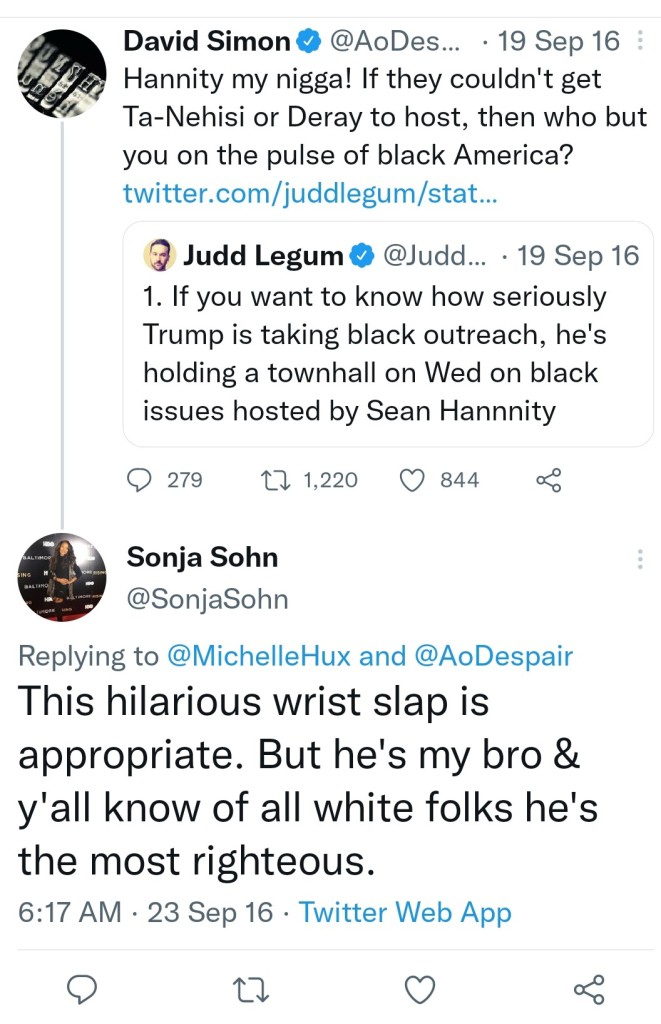
White moderates have been the bane of activists toiling about in the struggle demanding the end of white supremacy even before Rev. Dr. Martin Luther King wrote about his in exasperation in a letter from the Birmingham jail in 1963. The audacity of white men who as King noted have not seen “hate filled policemen curse, kick, brutalize and even kill your black brothers and sisters with impunity” to suggest a more palatable way to be treated as a full citizen that should come as a birth right.
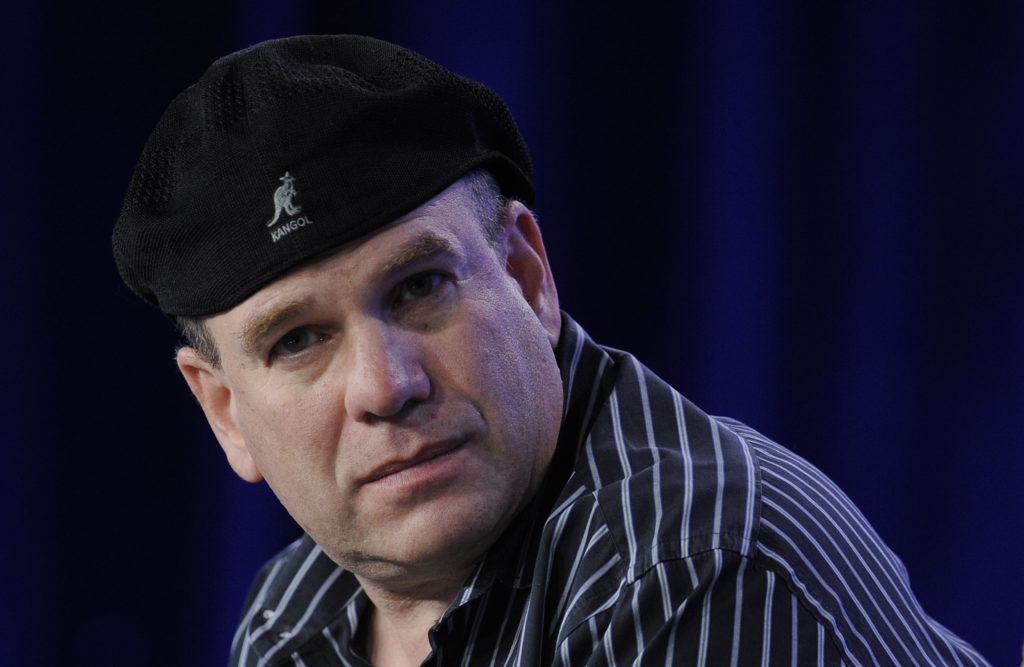
When dripping from white lips, the dark stain that comes word “nigger” triggers the blood memory of violence, angst, subjugation. While Simon relishes its artistry, he simultaneously riles the sensibilities of our ancestors even 60 years after King’s admonishment. No federal holiday commemorating the end of enslavement championed by a white moderate cis gendered male president can provide a respite from the likes of David Simon and his devoted legion of outspoken white male fans.
What is insufferable though about the creator of the 20-year old cop drama is his “whitesplaining” to Black people how his artful use of the word is not of the offensive variety. It is this audacity that shifts the responsibility for peoples’ recoil squarely back on their Black shoulders. It’s satire, he proclaimed frequently, evoking the “fuck ’em if they can’t take a joke” axiom.
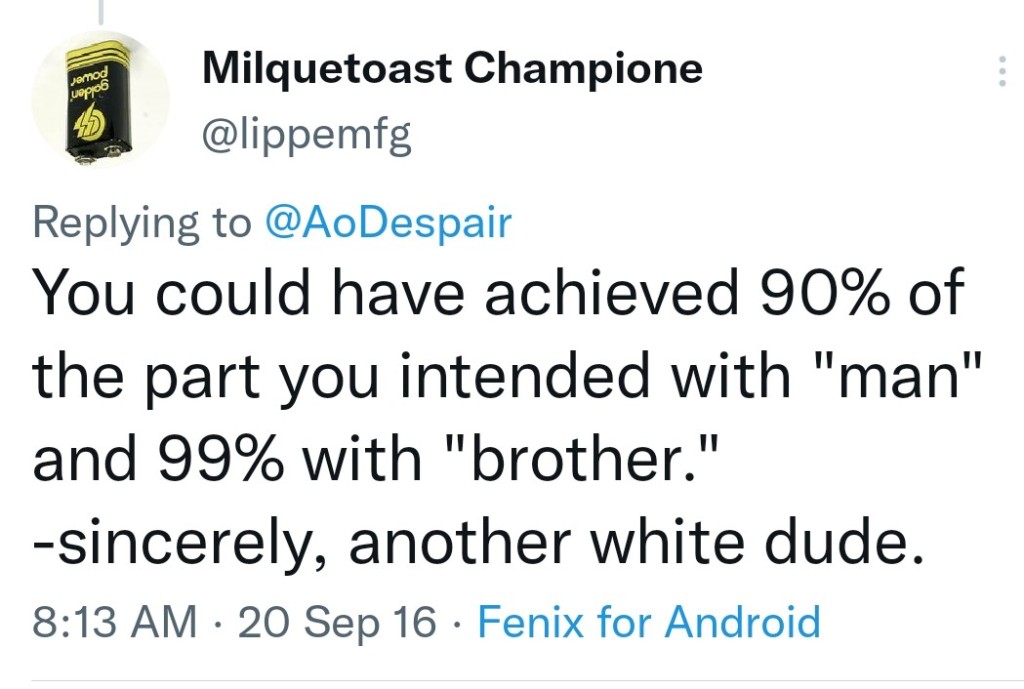
Weeks after initially posting and defending his choice, Simon displayed a small measure of introspection with two tweets on September 20, 2016: “Don’t see it as an imprecise choice, but do I wish I tried another tack to insult Fox’s racial hegemony? Sure.” Long after Trump lost his re-election bid, and with the benefit of hindsight, David Simon responded, but not with an apology. “Stand by it as an answer to a white racist…” Simon Tweeted on June 20, 2019. The tweet remains live today on Elon Musk’s Twitter even after the murderous death of George Floyd and the immergence of the Black Lives Matter movement.
Truth is, Simon knows his white male privilege. The wrists slaps were factored into his calculation for all chances he took once he left the DMV for Baltimore. He spoke on his world view to graduates of his alma mater, Chevy Chase-Bethesda High school, knew it too when he spoke at the 2012 graduation:
“Certain things were assumed for my life. The guardrails were all there. The airbags all worked. I might come through with a few dents and scratches, I might screw up here and there, but by and large, the risks I was asked to take were for the most part moderate and plausible. I was going to have to work some, and get a little lucky, sure. But for real, I grew up in Montgomery County, Maryland. I mean, damn. Nice work if you can get it.”
Simon’s Revoked Hall Pass
Simon was given an inch of rope and thought he was a cowboy. “Nigga” stopped being something a Black character said and something the white David Simon tossed around carelessly. For introducing the Stringer Bell and Omar to the world, David Simon was given a temporary pass similar to the one Samuel L Jackson extended to Quentin Tarantino.

Undated. Uncredited.
Simon’s temporary pass for saying that one word was identical to the laminated one former president Bill Clinton stores along with an emergency condom in his pocket. The pass was granted to Simon to use poetically in telling our stories; Clinton was offered one for playing the Saxaphone on Arsenio Hall’s late night talk show. Both white men have shown that all passes extended should be hereby immediately revoked. No white male moderate American should be issued another pass in the future.
Before the Fox News dust up that got tongues wagging, Simon took “nigger” out for a test run on Twitter two months earlier. No one barely noticed. Using the same tactics, Simon donned the persona of former president Richard Nixon and attacked the policies of then-presidential candidate Donald Trump:
“…let’s clamp down on the hippies and the niggers and the eggheads who are fucking us up”
David Simon, Twitter July 12, 2016
Since his coat was not severely pulled for that transgression in September, Simon put on the equivalence of Black face and started the shuck and jive routine against Hannity – this time for a larger audience.
The Washington Post made Simon’s transgression palatable to its white moderate readership when it rhetorically presented Simon’s defenders’ point of view that Simon has carte blanche to use the word because he wrote artful television shows in the realism prism depicting multi-dimensional Black characters.
If you’re not black you shouldn’t be saying “Nigga”. Plain and simple… If you can omit ‘faggot’ and ‘bitch’ from your vocabulary then why is it so hard and strenuous for you to omit ‘nigga’?
Malcolm-Aimé Musoni, HuffPost.com September 26, 2015
Racism and misogyny rest comfortably within Simon’s wheelhouse. It’s been pointed out that the reasons white males bristle over the n-word is explicitly because it’s off-limits to them. Hollywood writer/producer/actor Quentin Tarantino famously penned the word “nigger” as dialogue for himself to utter on screen.

On his personal blog, on the day commemorating Juneteenth in 2013, Simon wrote about data mining, specifically cell phone’s metadata and peoples’ right to privacy in an essay that he titled The “Nigger Wake-Up Call.” It is painfully clear that the joke went over Simon’s head. Paul Mooney’s running gag is about Blacks who are suddenly jarred into reality after believing they had achieved post-racial equality.
Simon usurped Mooney’s comedic genius for the shock value of merely using the word. What is the point of having the pass, if you don’t use it, eh David?
Simon’s ability to write authentic dialogue reflective of his immersion into Baltimore’s street culture as an observer allows him extreme latitude in his personal interactions to call people “nigger” or “nigga”. In this case, he used the latter, a distinction he made without commenting on the difference between the two.
“Simon’s works have made him a sort of elder statesman regarding the intersection of race, politics and socioeconomics in America
Cleve R. Wootson Jr, Washington Post. September 20, 2016.
Simon himself rejected the idea that he has a pass to use the n-word indiscriminately. He wrote on Twitter (which oddly enough is akin to him saying the words from his own mouth) on October 7, 2016: “And if I used the term on AA, hand me my head. Satirically, on a white con man claiming rep of AA interests? Hey.”
It should be noted also, that Simon uses African American, AA, and black (not capitalized) without any clear distinction of why. Journalists abide by AP stylebook which requires capitalization of Black as a race and the distinguishes African American as applying to both race and ethnicity, but are not interchangeable.
“Simon is no longer just a journalist or a writer: he’s become a de facto translator for middle class audiences looking to understand elements of black America.”
Lanre Bakare, “Go home, David Simon. Without Justice in Baltimore, there can be no peace. The Guardian.com 28 April 2015
The Enemy of my Enemy is a Friend Fallacy
Pinpointing the extent of Simon’s supposed allyship requires the dexterity of Simone Biles. For instance, in July 2019 when Donald Trump blasted west Baltimore as “rat invested” and placed blame squarely on then Congressman Elijah Cummings, Simon lashed out at Trump and called him a “racist moron.” Simon’s defense of his adopted city has ingratiated Simon into many locals’ good graces.
However, in 2015 when Freddie Gray was killed in custody of the Baltimore Police Department, Simon seemed more aligned with law and order than the community marching in the streets. In fact, once Baltimoreans took to the street as an uprising against racial oppression was brewing, Simon penned a plea for an end to direct action.
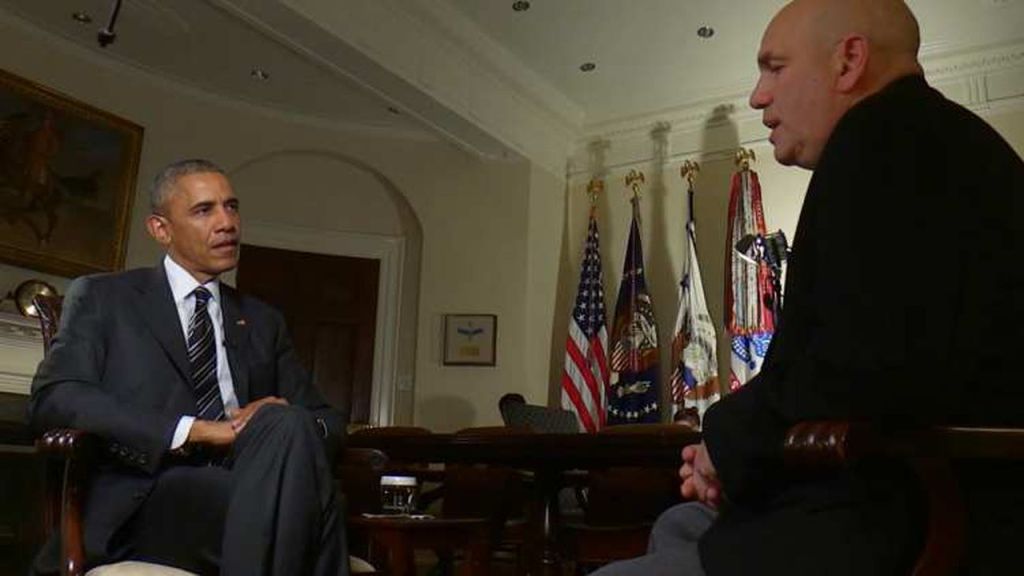
“White people — even those who speak up about black causes, like Simon — don’t have the social capital to throw around the n-word in everyday speech,” said author Jody Armour as quoted by the same 2016 Washington Post article.
Enter the Wu-Tang
If David Simon stopped saying “nigger” his family would starve. He is royally compensated many times over for putting “nigger” on a page. Unscientifically, David Simon has written the word hundreds (if not thousands) of times.
His seminal work, The Wire ran for six seasons and has a loyal fan base. During its 10-year heyday, his internal voice must have tried out every iteration of that word’s pronunciation. But Simon says he’s never “said” the word. (If he read any of his scripts out loud, merely playing the percentages, he has surely said “nigger”).
- “Nigga, is you taking notes on a criminal fucking conspiracy?! The fuck is you thinking, man?”
- “The crown ain’t worth much if the nigger wearing it always getting his shit took.”
- “Fuck them West Coast niggers, cause in B’more, we aim to hit a nigger, you heard?”
- “This motherfucker be killing niggas just to do it. You see? Nigga kills motherfuckers just cause he can. Not cause they snitching, not cause it’s business, but just because this shit comes natural to him. Man, Little Kevin is gone! This nigga don’t feel nothing!”
Not to split hairs, but an argument could be made that there’s a world of difference between writing dialogue for a “gritty” “urban” television drama and when someone uses their personal Twitter account to flaunt their pass to their 334,000 followers gained as a result of their Hollywood celebrity status. The former is economic, the latter is all ego.
As the rapper Method Man (who portrays Melvin Wagstaff in season two of The Wire) of the Wu Tang Clan drops a verse in the 2014 hit CREAM:
Cash rules everything around me
C.R.E.A.M., get the money
Dollar dollar bill, y’all
Before there was beaucoup money to be made in a cinematic depiction of Black Baltimore, there was the use of “nigger” in Simon’s journalism career at the Baltimore Sun.
Simon’s literary success was sparked by shadowing Black people’s daily struggle of existence in West Baltimore as a journalist. He culminated the experience not by lobbying for resources, but by writing a 1997 book The Corner: A Year in the Life of an Inner-City Neighborhood that he co-wrote with Baltimore Police Department (BPD) detective Ed Burns.
Simon’s first book mentions “nigger” 47 times and “nigga” four.
The book was made into a critically acclaimed HBO six-part mini-series The Corner, directed by Baltimorean Charles “Roc” Dutton, who is Black. Residual checks keep coming. In contrast, odds are that the Black youth he shadowed in order to craft a realistic creative expression are in jail, prison, on parole or probation.
On DavidSimon.com, he lists two charities as “worthy causes“: The Ella Thompson Fund and The Baltimore Station as well as one scholarship fund. Simon wrote it is “probable that [donations to the organizations listed] will directly address an issue locale or dynamic that we dramatized.”
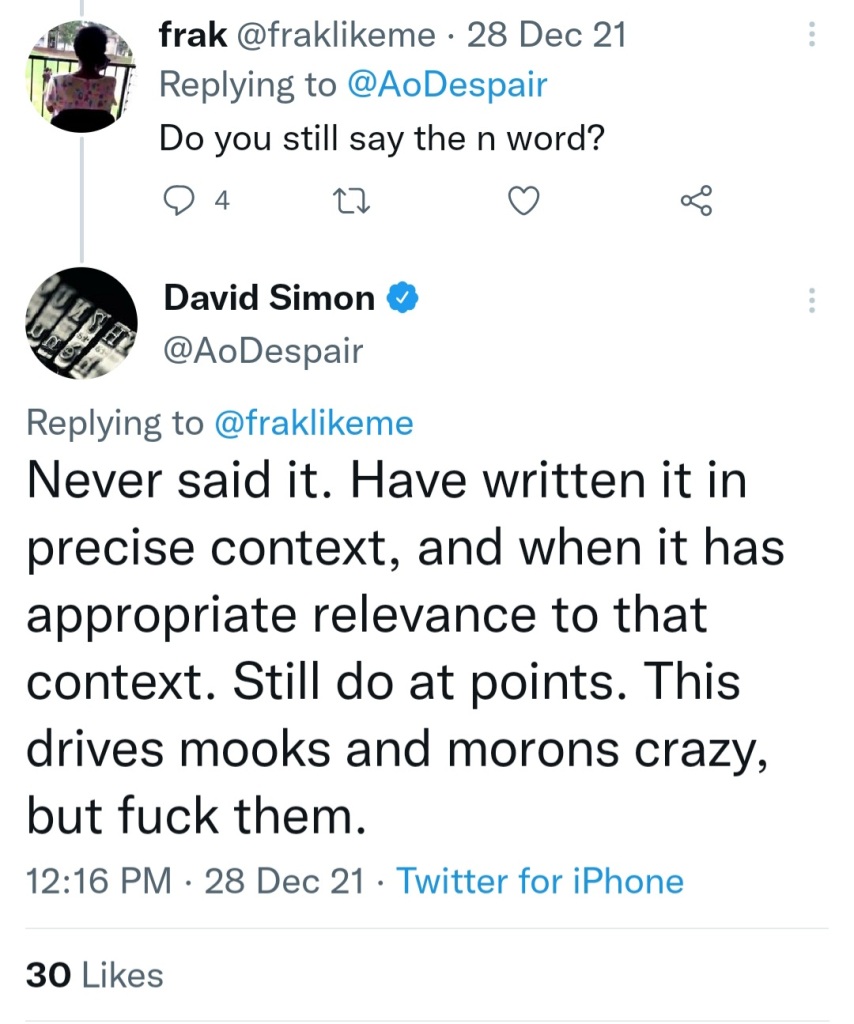
The Sun Rises on The N-Word: David’s Early Years
It is difficult to pinpoint with any degree of accuracy exactly when David Simon began taking a liking to the word tied to generational oppression of a people from African descent.
As is the moderate’s want to ask “where are his parents?, Simon admits the complexities of race was not a matter discussed at all in his house. In the next (and final) part of this series, the genealogy of Simon is explored putting into historical context some of the influences that undoubtedly shaped his world view.
Once the college grad from the Washington DC suburbs was dropped into Baltimore in the early 1980s, it was no doubt a culture shock. It would be totally understandable if the word “nigga” being tossed around like crime scene tape sent the cub reporter on the cops beat into full blush.
What was Baltimore to a kid from Montgomery County? It was another world, another America. Maybe not all of the city, but those quadrants that had been left behind…
David Simon, Graduation remakes, Bethesda-Chevy Chase High School June 4, 2012
Simon’s first few years as a working journalist at the Baltimore Sun was an extension of his self-proclaimed college years – lazy and uninspired. From 1982 through 1984 the assignments were routine, and the reporting was generic; the combination offered little by way of opportunity to hone a writing style.
There were glimpses, though. Simon shone a sympathetic light on libertarian Warren Eilerston who beat federal criminal charges for refusing to pay federal taxes in August 1983. Also, in 1985, Simon deftly covered a shift in BPD policy after the public balked at the lack of transparency after a string of police shootings where the officers were either not identified to members as part of a “news blackout” and/or the officer refused to give a statement to investigators.
It would not be long before Simon’s byline would be inked above the word “nigger” published in the city’s paper of record. The subject of the 1988 story was a 51-year old resident of Baltimore’s Cherry Hill neighborhood who worked as a barmaid in 1963.
It was the occasion of the 25th anniversary of a murderous hate-crime where Hattie Carroll was caned to death by 24-year old William Santzinger for not bringing a white man’s drink fast enough in a downtown Baltimore bar.
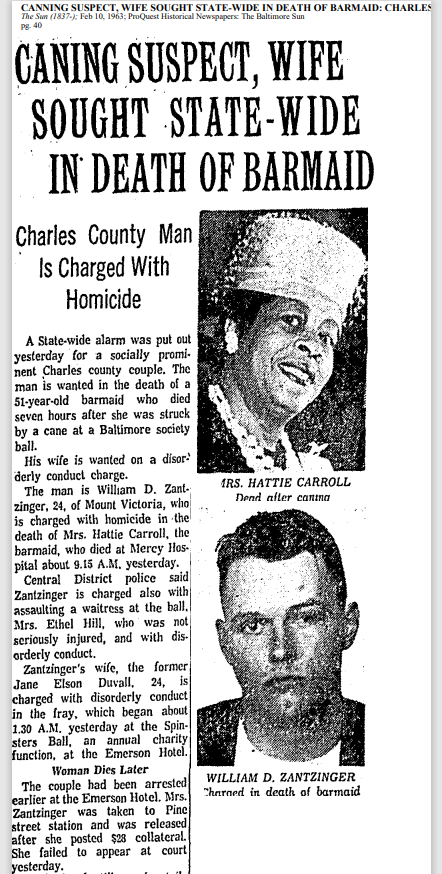
In the 1988 story about the death of Hattie Carroll, Simon showed both his burgeoning talent for a narrative style of journalism. The man who killed Carroll for not bringing him his drink quick enough had spent the evening terrorizing the wait staff at the hotel. He called one woman a Black bitch. He also hit several people with his cane during the “Spinster’s Ball” a charity event attended by Baltimore’s society elite.
It was also perhaps Simon’s earliest recorded use of the word “nigger”. It was printed for no good reason. For that, the Baltimore Sun should apologize.
The word set in a line and paragraph all to itself.
It had no voice or quotation marks. It was David Simon’s voice caressing the word “nigger”:

The Sun really had no journalistic rationale for printing the racial epitaph gratuitously added by David Simon. The only context provided was that while visiting Charles County, the home of the man who killed Carroll, Simon supposedly witnessed the word’s wide use among whites in southern Maryland’s rural communities. Simon included in his story an unidentified white man (supposedly granted anonymity) from Charles County who wished “black people the best of everything, really.”
From that point in 1988, Simon took leave from The Baltimore Sun again and spent a year embedded with the Baltimore Police Department as its intern. His experience shadowing Baltimore Police Department (BPD) was memorialized in a 1991 book, that was later made into a television show for NBC, Homicide, Life on the Street. “Nigger” appears five times in the book; there’s no mention of “Nigga.”
Nor was [BPD] the most tolerant environment in which to come of age; there were cops twenty years younger who reacted to what they saw on the streets by crawling into a psychological cave, damning every nigger and liberal faggot to hell for screwing up the country
David Simon. Homicide A Year on the Killing Streets 1991
Simon’s “Nigger” Code
David Simon, much like the police he covered while a cops reporter in Baltimore, has somewhat of a code that dictates how he uses the word.
“Nigger” or “nigga” it seems is not something Simon feels that he say verbally out loud, in public. If he writes it out (in a tweet or essay), he is not restricted. However, he will take pause before he uses “my nigga” in writing if its directed to someone Black.
If it’s written as satire or in the voice of a persona he is co-opting, then he can pretend to be Black and use the word, but only direct it towards someone who is white.
The code allows Simon to write the word for characters to say as dialogue. He is also able to have a narrator describe someone as a nigger. Simon is the sole arbiter as to how many times he can write the word and if it is offensive. He believes his pass is unlimited.
Simon has not made any distinction between ending the word with an “r” or an “a”. But as stated earlier, his book The Corner uses “nigger” 10 times more frequently than “nigga”.
“David Simon is the blackest white man I have ever known. What he wrote was clearly ironic, and entirely at the expense of the whitest white man on the planet. I see no foul.”
Gene Weingarten, Washington Post columnist and Simon’s writing partner.
Sorry, Not Sorry
What seems most clear about Simon’s code is that he should never apologize when he uses it.
David Simon said that if he did delete the Hannity tweet he feared that in the void someone would claim that “I used the phrase to do anything other than to ironically mock someone’s actual co-opting of racial status [emphasis added] in order to advance their racist candidate.”
Let’s unpack the statement. First, he is arguing that if deleted, saved screenshots would also disappear from this known dimension thusly preventing him from pointing out the original context. Next, he insists that he was being ironic in mocking a white man who Simon believes to be racist by engaging him with a racially explosive word. In turn, no one focused on Hannity’s “co-opted racial status” but much of the world took Simon to the woodshed for his wanton use of a racist term. Now, that’s ironic.
